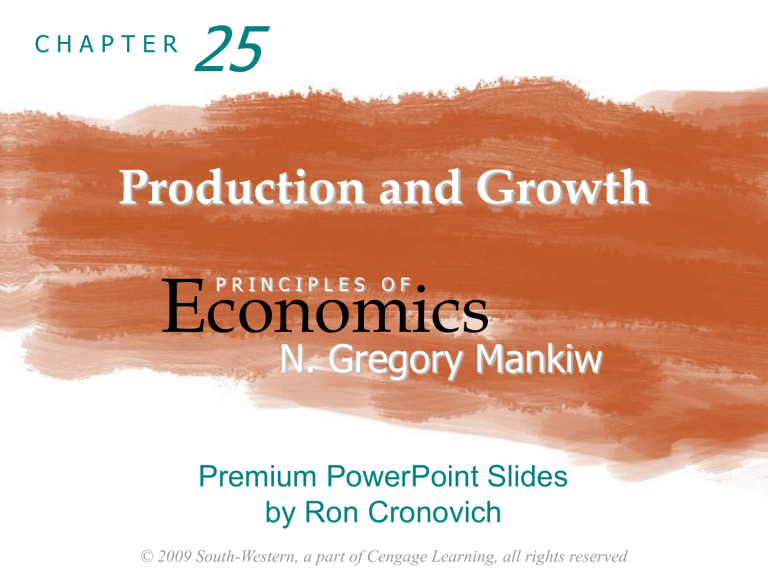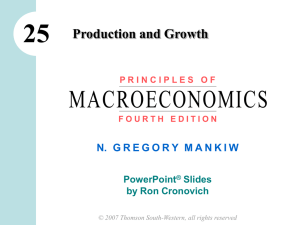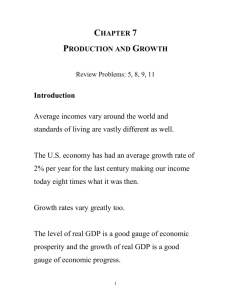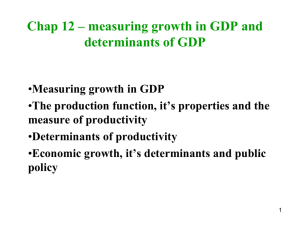
CHAPTER
25
Production and Growth
Economics
PRINCIPLES OF
N. Gregory Mankiw
Premium PowerPoint Slides
by Ron Cronovich
© 2009 South-Western, a part of Cengage Learning, all rights reserved
In this chapter,
look for the answers to these questions:
What are the facts about living standards and
growth rates around the world?
Why does productivity matter for living standards?
What determines productivity and its growth rate?
How can public policy affect growth and living
standards?
1
A typical family with all their possessions
in the U.K., an advanced economy
GDP per capita:
Life expectancy:
Adult literacy:
$35,580
79 years
99%
A typical family with all their possessions
in Mexico, a middle income country
GDP per capita:
Life expectancy:
Adult literacy:
$11,410
76 years
92%
A typical family with all their
possessions in Mali, a poor country
GDP per capita:
Life expectancy:
Adult literacy:
$1,130
50 years
46%
Incomes
and Growth
Around the
World
China
Singapore
Japan
Spain
FACT 1:
India
Israel
There are
United States
vast
Canada
differences
Colombia
in living
New Zealand
standards
Philippines
around the
Argentina
Saudi Arabia
world.
Rwanda
Haiti
PRODUCTION AND GROWTH
GDP per
Growth rate,
capita, 2005 1960-2005
$6,572
29,921
30,821
26,125
3,486
25,670
41,854
32,886
7,769
22,511
4,920
14,421
14,729
1,333
1,836
5.8%
5.4%
3.8%
3.2%
2.7%
2.7%
2.2%
2.1%
1.8%
1.4%
1.4%
1.0%
0.8%
0.3%
–1.2%
5
Incomes
and Growth
Around the
World
China
Singapore
Japan
Spain
FACT 2:
India
Israel
There is
United States
also great
Canada
variation
Colombia
in growth
New Zealand
rates across
Philippines
countries.
Argentina
Saudi Arabia
Rwanda
Haiti
PRODUCTION AND GROWTH
GDP per
Growth rate,
capita, 2005 1960-2005
$6,572
29,921
30,821
26,125
3,486
25,670
41,854
32,886
7,769
22,511
4,920
14,421
14,729
1,333
1,836
5.8%
5.4%
3.8%
3.2%
2.7%
2.7%
2.2%
2.1%
1.8%
1.4%
1.4%
1.0%
0.8%
0.3%
–1.2%
6
Incomes and Growth Around the World
Since growth rates vary, the country rankings can
change over time:
Poor countries are not necessarily doomed to
poverty forever – e.g., Singapore, incomes were
low in 1960 and are quite high now.
Rich countries can’t take their status for granted:
They may be overtaken by poorer but
faster-growing countries.
PRODUCTION AND GROWTH
7
Incomes and Growth Around the World
Questions:
Why are some countries richer than others?
Why do some countries grow quickly while others
seem stuck in a poverty trap?
What policies may help raise growth rates and
long-run living standards?
PRODUCTION AND GROWTH
8
Productivity
Recall one of the Ten Principles from Chap. 1:
A country’s standard of living depends
on its ability to produce g&s.
This ability depends on
productivity, the average quantity of g&s
produced per unit of labor input.
Y = real GDP = quantity of output produced
L = quantity of labor
so productivity = Y/L (output per worker)
PRODUCTION AND GROWTH
9
Why Productivity Is So Important
When a nation’s workers are very productive,
real GDP is large and incomes are high.
When productivity grows rapidly, so do living
standards.
What, then, determines productivity and its
growth rate?
PRODUCTION AND GROWTH
10
Physical Capital Per Worker
Recall: The stock of equipment and structures
used to produce g&s is called [physical] capital,
denoted K.
K/L = capital per worker.
Productivity is higher when the average worker
has more capital (machines, equipment, etc.).
i.e.,
an increase in K/L causes an increase in Y/L.
PRODUCTION AND GROWTH
11
Human Capital Per Worker
Human capital (H):
the knowledge and skills workers acquire through
education, training, and experience
H/L = the average worker’s human capital
Productivity is higher when the average worker
has more human capital (education, skills, etc.).
i.e.,
an increase in H/L causes an increase in Y/L.
PRODUCTION AND GROWTH
12
Natural Resources Per Worker
Natural resources (N): the inputs into production
that nature provides, e.g., land, mineral deposits
Other things equal,
more N allows a country to produce more Y.
In per-worker terms,
an increase in N/L causes an increase in Y/L.
Some countries are rich because they have
abundant natural resources
(e.g., Saudi Arabia has lots of oil).
But countries need not have much N to be rich
(e.g., Japan imports the N it needs).
PRODUCTION AND GROWTH
13
Technological Knowledge
Technological knowledge: society’s
understanding of the best ways to produce g&s
Technological progress does not only mean
a faster computer, a higher-definition TV,
or a smaller cell phone.
It means any advance in knowledge that boosts
productivity (allows society to get more output
from its resources).
E.g., Henry Ford and the assembly line.
PRODUCTION AND GROWTH
14
Tech. Knowledge vs. Human Capital
Technological knowledge refers to society’s
understanding of how to produce g&s.
Human capital results from the effort people
expend to acquire this knowledge.
Both are important for productivity.
PRODUCTION AND GROWTH
15
The Production Function
The production function is a graph or equation
showing the relation between output and inputs:
Y = A F(L, K, H, N)
F( ) – a function that shows how inputs are
combined to produce output
“A” – the level of technology
“A” multiplies the function F( ),
so improvements in technology (increases in “A”)
allow more output (Y) to be produced from any
given combination of inputs.
PRODUCTION AND GROWTH
16
The Production Function
Y = A F(L, K, H, N)
The production function has the property
constant returns to scale: Changing all inputs
by the same percentage causes output to change
by that percentage. For example,
Doubling all inputs (multiplying each by 2)
causes output to double:
2Y = A F(2L, 2K, 2H, 2N)
Increasing all inputs 10% (multiplying each by 1.1)
causes output to increase by 10%:
1.1Y = A F(1.1L, 1.1K, 1.1H, 1.1N)
PRODUCTION AND GROWTH
17
The Production Function
Y = A F(L, K, H, N)
If we multiply each input by 1/L, then
output is multiplied by 1/L:
Y/L = A F(1, K/L, H/L, N/L)
This equation shows that productivity
(output per worker) depends on:
the level of technology (A)
physical capital per worker
human capital per worker
natural resources per worker
PRODUCTION AND GROWTH
18
ACTIVE LEARNING
1
Discussion Question
Which of the following policies do you think would
be most effective at boosting growth and living
standards in a poor country over the long run?
a. Offer tax incentives for investment by local firms
b.
”
”
”
”
”
by foreign firms
c. Give cash payments for good school attendance
d. Crack down on govt corruption
e. Restrict imports to protect domestic industries
f. Allow free trade
g. Give away condoms
19
ECONOMIC GROWTH
AND PUBLIC POLICY
Next, we look at the ways
public policy can affect
long-run growth in productivity
and living standards.
PRODUCTION AND GROWTH
20
Saving and Investment
We can boost productivity by increasing K,
which requires investment.
Since resources scarce, producing more capital
requires producing fewer consumption goods.
Reducing consumption = increasing saving.
This extra saving funds the production of
investment goods. (More details in the next chapter.)
Hence, a tradeoff between current and future
consumption.
PRODUCTION AND GROWTH
21
Diminishing Returns and the Catch-Up Effect
The govt can implement policies that raise saving
and investment. (Details in next chapter.)
Then K will rise, causing productivity and living
standards to rise.
But this faster growth is temporary,
due to diminishing returns to capital:
As K rises, the extra output from an additional
unit of K falls….
PRODUCTION AND GROWTH
22
The Production Function & Diminishing Returns
If workers
Output per
have little
K,
worker
giving
them more
(productivity)
increases their
productivity a lot.
If workers already
have a lot of K,
giving them more
increases
productivity
fairly little.
PRODUCTION AND GROWTH
Y/L
K/L
Capital per worker
23
The catch-up effect: the property whereby poor
countries tend to grow more rapidly than rich ones
Y/L
Rich country’s
growth
Poor country’s
growth
K/L
Poor country
starts here
PRODUCTION AND GROWTH
Rich country starts here
24
Example of the Catch-Up Effect
Over 1960-1990, the U.S. and S. Korea devoted
a similar share of GDP to investment, so you
might expect they would have similar growth
performance.
But growth was >6% in Korea and only 2% in the
U.S.
Explanation: the catch-up effect.
In 1960, K/L was far smaller in Korea than
in the U.S., hence Korea grew faster.
PRODUCTION AND GROWTH
25
Investment from Abroad
To raise K/L and hence productivity, wages, and
living standards, the govt can also encourage
foreign direct investment:
a capital investment (e.g., factory) that is
owned & operated by a foreign entity
foreign portfolio investment:
a capital investment financed with foreign
money but operated by domestic residents
Some of the returns from these investments
flow back to the foreign countries that supplied
the funds.
PRODUCTION AND GROWTH
26
Investment from Abroad
Especially beneficial in poor countries that cannot
generate enough saving to fund investment
projects themselves.
Also helps poor countries learn state-of-the-art
technologies developed in other countries.
PRODUCTION AND GROWTH
27
Education
Govt can increase productivity by promoting
education–investment in human capital (H).
Public schools, subsidized loans for college
Education has significant effects: In the U.S., each
year of schooling raises a worker’s wage by 10%.
But investing in H also involves a tradeoff
between the present & future:
Spending a year in school requires sacrificing
a year’s wages now to have higher wages later.
PRODUCTION AND GROWTH
28
Health and Nutrition
Health care expenditure is a type of investment in
human capital – healthier workers are more
productive.
In countries with significant malnourishment, raising
workers’ caloric intake raises productivity:
Over 1962-95, caloric consumption rose 44% in
S. Korea, and economic growth was spectacular.
Nobel winner Robert Fogel:
30% of Great Britain’s growth from 1790-1980
was due to improved nutrition.
PRODUCTION AND GROWTH
29
Property Rights and Political Stability
Recall:
Markets are usually a good
way to organize economic activity.
The price system allocates resources
to their most efficient uses.
This requires respect for property rights, the
ability of people to exercise authority over the
resources they own.
PRODUCTION AND GROWTH
30
Property Rights and Political Stability
In many poor countries, the justice system
doesn’t work very well:
Contracts aren’t always enforced
Fraud, corruption often go unpunished
In some, firms must bribe govt officials for
permits
Political instability (e.g., frequent coups) creates
uncertainty over whether property rights will be
protected in the future.
PRODUCTION AND GROWTH
31
Property Rights and Political Stability
When people fear their capital may be stolen by
criminals or confiscated by a corrupt govt,
there is less investment, including from abroad,
and the economy functions less efficiently.
Result: lower living standards.
Economic stability, efficiency, and healthy growth
require law enforcement, effective courts,
a stable constitution, and honest govt officials.
PRODUCTION AND GROWTH
32
Free Trade
Inward-oriented policies
(e.g., tariffs, limits on investment from abroad)
aim to raise living standards by avoiding
interaction with other countries.
Outward-oriented policies (e.g., the elimination
of restrictions on trade or foreign investment)
promote integration with the world economy.
PRODUCTION AND GROWTH
33
Free Trade
Recall: Trade can make everyone better off.
Trade has similar effects as discovering new
technologies – it improves productivity and living
standards.
Countries with inward-oriented policies have
generally failed to create growth.
E.g., Argentina during the 20th century.
Countries with outward-oriented policies have
often succeeded.
E.g., South Korea, Singapore, Taiwan after 1960.
PRODUCTION AND GROWTH
34
Research and Development
Technological progress is the main reason why
living standards rise over the long run.
One reason is that knowledge is a public good:
Ideas can be shared freely, increasing the
productivity of many.
Policies to promote tech. progress:
Patent laws
Tax incentives or direct support for
private sector R&D
Grants for basic research at universities
PRODUCTION AND GROWTH
35
Population Growth
…may affect living standards in 3 different ways:
1. Stretching natural resources
200 years ago, Malthus argued that pop. growth
would strain society’s ability to provide for itself.
Since then, the world population has increased
sixfold. If Malthus was right, living standards would
have fallen. Instead, they’ve risen.
Malthus failed to account for technological
progress and productivity growth.
PRODUCTION AND GROWTH
36
Population Growth
2. Diluting the capital stock
Bigger population = higher L = lower K/L
= lower productivity & living standards.
This applies to H as well as K:
fast pop. growth = more children
= greater strain on educational system.
Countries with fast pop. growth tend to have lower
educational attainment.
PRODUCTION AND GROWTH
37
Population Growth
2. Diluting the capital stock
To combat this, many developing countries use policy
to control population growth.
China’s one child per family laws
Contraception education & availability
Promote female literacy to raise opportunity cost of
having babies
PRODUCTION AND GROWTH
38
Population Growth
3. Promoting tech. progress
More people
= more scientists, inventors, engineers
= more frequent discoveries
= faster tech. progress & economic growth
Evidence from Michael Kremer:
Over the course of human history,
growth rates increased as the world’s
population increased
more populated regions grew faster than
less populated ones
PRODUCTION AND GROWTH
39
ACTIVE LEARNING
2
Review productivity concepts
List the determinants of productivity.
List three policies that attempt to raise living
standards by increasing one of the determinants
of productivity.
40
ACTIVE LEARNING
2
Answers
Determinants of productivity:
K/L, physical capital per worker
H/L, human capital per worker
N/L, natural resources per worker
A, technological knowledge
Policies to boost productivity:
Encourage saving and investment, to raise K/L
Encourage investment from abroad, to raise K/L
Provide public education, to raise H/L
41
ACTIVE LEARNING
2
Answers
Determinants of productivity:
K/L, physical capital per worker
H/L, human capital per worker
N/L, natural resources per worker
A, technological knowledge
Policies to boost productivity:
Patent laws or grants, to increase A
Control population growth, to increase K/L
42
Are Natural Resources a Limit to Growth?
Some argue that population growth is depleting the
Earth’s non-renewable resources, and thus will limit
growth in living standards.
But technological progress often yields ways to avoid
these limits:
Hybrid cars use less gas.
Better insulation in homes reduces the energy
required to heat or cool them.
As a resource becomes scarcer, its market price
rises, which increases the incentive to conserve it
and develop alternatives.
PRODUCTION AND GROWTH
43
CONCLUSION
In the long run, living standards are determined by
productivity.
Policies that affect the determinants of productivity
will therefore affect the next generation’s living
standards.
One of these determinants is saving and
investment.
In the next chapter, we will learn how saving and
investment are determined, and how policies can
affect them.
PRODUCTION AND GROWTH
44
CHAPTER SUMMARY
There are great differences across countries in
living standards and growth rates.
Productivity (output per unit of labor) is the main
determinant of living standards in the long run.
Productivity depends on physical and human
capital per worker, natural resources per worker,
and technological knowledge.
Growth in these factors – especially technological
progress – causes growth in living standards over
the long run.
45
CHAPTER SUMMARY
Policies can affect the following, each of which has
important effects on growth:
Saving and investment
International trade
Education, health & nutrition
Property rights and political stability
Research and development
Population growth
Because of diminishing returns to capital,
growth from investment eventually slows down,
and poor countries may “catch up” to rich ones.
46







